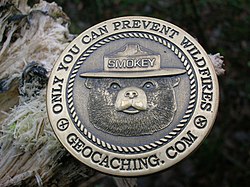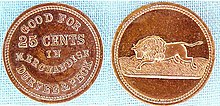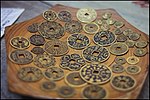Exonumia
This article includes a list of generalreferences,butit lacks sufficient correspondinginline citations.(December 2011) |

| Part ofa serieson |
| Numismatics the study of currency |
|---|
 |
Exonumiaarenumismaticitems (such astokens,medals,orscrip) other than coins and paper money. This includes "Good For" tokens, badges, counterstamped coins,elongated coins,encased coins, souvenir medallions, tags,wooden nickelsand other similar items. It is an aspect ofnumismaticsand manycoin collectorsare also exonumists.
Besides the above strict definition, others extend it to include non-coins which may or may not be legal tenders such ascheques,credit cardsand similar paper. These can also be considerednotaphilyorscripophily.
Etymology
[edit]The nounexonumiais derived from two classical roots:exo,meaning "out-of" inGreek,andnummus,meaning "coin" inLatin(from Greek νοῦμμος –noummos,"coin" ); thus, "out[side]-of-[the category]coins".[1]The equivalentBritishterm,paranumismatica,may also be used.[2]
The wordsexonumistandexonumiawere coined in July 1960 byRussell Rulau,[3]a recognized authority and author on the subject, and accepted byWebster's dictionaryin 1965.
Token coins
[edit]Many tokens were produced and used as currency in the United States and elsewhere when there was a shortage of government-issued money. Tokens have been used for both to advertise and to facilitate commerce and may or may not have a value.
Token authorityRussell Rulauoffers a broad definition for exonumia in his 1040 page tome,UNITED STATES TOKENS: 1700–1900[4]but lines between categories can be fuzzy. For example, an advertising token may also be considered a medal.Good Fortokens may also advertise. Counter-stamped coins have been called "little billboards."
One way of parsing tokens is into these three general categories:
- Has a "value," facilitating commerce, such asGood for (something).
- Commemoration, remembrance, dedication, or the like, for some person, place, idea or event.
- Of apersonal nature.
Typically, catalogs of tokens are organized by location, time period, and/or type of item. Historically, the need for tokens grew out of the need for currency. In America, some tokens legally circulated alongside or instead of currency.Hard Times TokensandCivil War tokenseach were the size of the contemporary cent. Afterwards, value based items, such asGood for (amount of money),Good for One Quart of Milk,Good for One Beer,Good for One Ride…and others were specifically linked to commerce of the store or place of issue.
Medals
[edit]Medals are coin-like artistic objects, typically with a commemorative purpose. They may be awarded for recognition of achievement or created for sale to commemorate individuals or events. They may be souvenirs, devotional, or purely artistic. Medals are generally not used as currency or for exchange.
Exonumia collecting
[edit]Exonumia collectors, like coin collectors, are attentive to condition and rarity, as well as to history, form and type. Exonumists may collect items by region, topic, type, shape or material and this affects the ways tokens are documented.
The following categories are typical. This is not all-inclusive but is a sampling of the wide variety of exonumia.
By type
[edit]Modified/augmented:
- Love Token: A coin with hand engraving, generally on one side, or deliberately bent.
- Carved Potty coins: usuallyUnited States Seated Liberty coinagecarved to show lady Liberty sitting on a chamber pot.
- Hobo nickels:Initially, hand-engravedBuffalo nickelsmostly in the era 1913–38. Now, applied more generally to hand-engraved coins of different denominations.
- Counterstamped/countermarkedorchoppedcoins (done by merchants or governments)
- Cut Coins: artistically carved creations made from genuine coins, both new and old, often for jewelry.
- Elongated coins:Rolled out with advertising, commemorative, or souvenir designs on one side
- Encased Coin: Generally in a ring with advertising
- Colored or painted circulation or bullion issues
- Short snorter:paper money signed by people sharing a common experience
- Coin slabs:rare or sample slabs[5]

Play money / fantasy / counterfeit / art
- Play money
- Fantasy issueor novelty money (e.g.Promotional fake United States currency,Prop money)
- Mardi Gras Doubloons
- Counterfeit coinsincludingevasion tokens[6]
- Money art
Government services & non-national tools to facilitate commerce
- Jetons:Used as counters when verifying totals or weights of coins for commerce and exchange
- Telephone tokens/Gettoni
- Local currency,e.g.Ithaca Hours
- Sales tax tokens:Issued by states and merchants
- Dog license tags
- Post office tags
- Ration tokens, e.g.OPA tokens
- Food stamps
- Slave tags: seeSlave codes
Transportation tokens
- Ferries and watercraft
- Buses
- Subway
- Trains
- Trams/Trolleys
Closed community / membership
- Communion tokens:given to congregation members to permit them to participate inHoly Communion)
- Company scrip
- Ingle Credit System script
- Lumber
- Mining
- Civilian Conservation Corps(CCC)
- College Currency
- Challenge coins
- Fraternal
- Geocoinsused in geocaching
- Leper colony money
- Military
- Military payment certificate
- Allied Military Currency
- Japanese invasion money
- canteen, mess hall, NCO club tokens
- Plantation
- Picker tokens for crops
- Prison and Correctional/Asylums
- Sobriety coin

By material / shapes
- Wooden nickels
- Cardboard or paper
- Hard rubber orebonite
- Bullion,e.g. non-legal tendersilver rounds
Movements and ideals
- Temperance
- Anti-slavery
- Religious (including temple tokens)
- Political tokens, e.g.Bryan Money
Of a personal nature – personals
- Key tags (e.g.In case lost return to…)
- Badges
- Company
- Occupation
- Hand-engraved or uniquely counterstamped coins, as pocket pieces
- Watch fobs

By issuer
- Arcade/Amusementtokens
- Apothecary tokens
- Bakery token
- Beer
- Pub/bar/saloon
- Billiards/pool
- Brothel tokens
- Car washtokens
- Casino/Slot tokens/Casino chips
- Cigar/smoke shops
- Coat check
- Disney Dollars
- Fisherman tokens
- Milk/dairy
- Parking tokens: formetersorgates
- Pay toilettokens
- Peep show
- Railway cheque tokens
Medals
- Politicians, inventors and other notables, e.g.George Washington
- World's fairsor other expositions
- City or state anniversaries
- So-called dollars: medals and souvenirs similar in size to a silver dollar commemorating American historical events such as world's fairs, anniversary celebrations, dedications, battles, public works projects, etc.[7]
Modern itemsunder the exonumia umbrella include:
- Credit cards
- Gift cards
- Telephone cards
- Music cards
By region
[edit]China
[edit]There are many types of Chinese exonumia, including alternative currencies:
- Buddhist coin charm
- Burial money
- Confucian coin charm
- Horse coin
- Hell money
- Lei Ting curse charm
- Marriage coin charm
- Open-work charm
- Vault protector coin
- Taoist coin charm
- Zhengde Tongbao
Germany
[edit]Notgeld,primarily in the form of paperbanknotes,was issued in Germany and Austria duringWorld War Iand theinterwar periodby towns, banks and other institutions due to a shortage of money.
Latin America
[edit]Latin Americancoffee or plantation tokens were an important part of commerce.[8]Many plantation owners had their own commissaries and workers used plantation tokens to pay for provisions. Many tokens were made in the United States or Europe. Plantation tokens had an array of denominations and names. The name can be the owner, their relatives or the name of the farm (or finca). Tokens had allegorical symbols to identify the owner. Tokens were used as currency when there was not enough official currency available. Workers could convert the tokens to official currency on Saturdays.[citation needed]
Tokens were made in all types of base metals and alloys plus plastic, celluloid andbakelite.Unique to Costa Rica were tokens made of paper (paper chits). The word "boleto" is used in Costa Rica for the word token whereas "ficha" is used in the rest of Latin America.
United Kingdom
[edit]Conder tokenswere privately mintedtokens from the later part of the 18th century and the early part of the 19th century inEngland,AngleseyandWales,Scotland,andIreland.
United States
[edit]
Rulau[4]breaks down American tokens into these general time periods:
- Early American
- Hard times tokenswere made during the "hard times"afterPresident Andrew Jacksonshut down theSecond Bank of the United States.These tokens were issued privately to circulate in the local economy as aone centcoin. They had a wide variety of subject matter, including advertising and political/satirical themes (anti-slavery, anti-Jackson).
- Civil War tokenswere made between 1861 and 1864 due to the scarcity of government-issued cents during theAmerican Civil War.Encased postage stampswere also used for this purpose.
- Merchant (including modern gas tokens, ex: Shell tokens)
- Trade tokens
- Gay 90s
See also
[edit]References
[edit]- ^"Exonumia".merriam-webster.com.Merriam-Webster.Retrieved8 June2024.
- ^Edge, Brian."PARANUMISMATICA DEFINED".coinbooks.org.The Numismatic Bibliomania Society (NBS).Retrieved8 June2024.
- ^"TAMS Frequently Asked Questions".tokenandmedal.org.Token and Medal Society (TAMS).Retrieved8 June2024.
- ^abRulau, Russell.Standard Catalog United States Tokens 1700-1900.
- ^Hoard, Kellen (2024-02-08)."Collecting Sample Slabs".The Reading Room.American Numismatic Association.Retrieved2024-05-18.
- ^McKivor, Bill."18th Century" EVASION "TOKENS".The Copper Corner.Archived fromthe originalon 2022-02-04.Retrieved2017-01-30.
The laws were written to cover Regal coinage. If a coin was made that was not an EXACT COPY of the Regal coin, it was considered to be a token, and the law did not apply. Thus, the counterfeiters simply switched from making counterfeit coins to making "Evasion" token coinage that looked somewhat like the regal coin.
- ^"Quick Introduction to So-Called Dollars".So-called Dollars.Retrieved9 September2023.
- ^Rulau, Russell.Latin American Tokens: An Illustrated, Priced Catalog of the Unofficial Coinage of Latin America—Used in Plantation, Mine, Mill, and Dock—From 1700 to the 20th Century.
Further reading
[edit]- Collecting U.S. Tokens: Challenges and Rewards, R. Leonard, Chicago Coin Club
- Trade Token Tales,an educational website on trade tokens
- PlantageGeld,Plantation tokens, mainly Netherlands East Indies, British North Borneo and Ceylon (in Dutch)
External links
[edit]- Token And Medal Society
- Civil War Token Society
- Richard's Token DatabaseSearchable database for Good For's and other items


